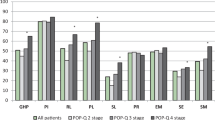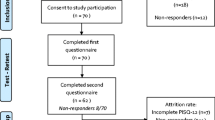Abstract
Introduction and hypothesis
We aimed to test validity, reliability and responsiveness of a Dutch version of a prolapse quality-of-life questionnaire (P-QoL).
Methods
P-QoL was translated into Dutch and adjusted by a panel of five experts. The scores of the final version were compared between symptomatic (n = 160) and asymptomatic (n = 80) patients and with findings on vaginal examination (pelvic organ prolapse quantification (POP-Q)). In terms of reliability, Cronbach’s alpha was calculated, and a test–retest (n = 20) was performed. Responsiveness to treatment was assessed by comparing pre- and postoperative scores in 45 patients.
Results
Total scores for each P-QoL domain were different between symptomatic and asymptomatic women (p < 0.001). Severity according to P-QoL correlated well with POP-Q findings. Cronbach’s alphas showed internal consistency within the domains. Test–retest reliability was high. Pre- and postoperative scores for each domain were significantly different (p < 0.001).
Conclusion
The Dutch version of P-QoL is valid, reliable and responsive to assess quality-of-life and symptoms in Dutch-speaking patients with urogenital prolapse.
Similar content being viewed by others
Abbreviations
- BMI:
-
Body mass index
- EF:
-
Effect size
- IIQ:
-
Incontinence impact questionnaire
- POP:
-
Pelvic organ prolapse
- POP-Q:
-
Pelvic organ prolapse quantification
- P-QoL:
-
Prolapse quality-of-life questionnaire
- QoL:
-
Quality-of-life
- SD:
-
Standard deviation
- SRM:
-
Standardised response mean
- UDI:
-
Urogenital distress inventory
References
Swift SE, Tate SB, Nicholas J (2003) Correlation of symptoms with degree of pelvic organ support in a general population of women: what is pelvic organ prolapse? Am J Obstet Gynecol 189(2):372–377
Digesu GA, Khullar V, Cardozo L, Robinson D, Salvatore S (2005) P-QoL: a validated questionnaire to assess the symptoms and quality of life of women with urogenital prolapse. Int Urogynecol J 6:176–181
Barber MD, Kuchibhatla MN, Pieper CF, Bump RC (2001) Psychometric evaluation of 2 comprehensive condition-specific quality of life instruments for women with pelvic floor disorders. Am J Obstet Gynecol 185(6):1388–1395
Digesu GA, Santamato S, Khullar V, Santillo V, Digesu A, Cormio G et al (2003) Validation of an Italian version of the prolapse quality of life questionnaire. Eur J Obstet Gynecol Reprod Biol 106(2):184–192
Cam C, Sakalli M, Ay P, Aran T, Cam M, Karateke A (2007) Validation of the prolapse quality of life questionnaire (P-QoL) in a Turkish population. Eur J Obstet Gynecol Reprod Biol 135(1):132–135
Fukumoto Y, Uesaka Y, Yamamoto K, Ito S, Yamanaka M, Takeyama M, Noma M (2008) Assessment of guality of life in women with pelvic organ prolapse: conditional translation and trial of P-Qol for use in Japan. Nippon Hinyokika Gakkai Zasshi 99(3):531–542
Lenz F, Stammer H, Brocker K, Rak M, Scherg H, Sohn C (2009) Validation of a German version of the P-QoL Questionnaire. Int Urogynecol J Pelvic Floor Dysfunct. doi:10.1007/s00192-009-0809-x
Messick S (1995) Validity of psychological assessment: validation of inferences from persons' responses and performance as scientific inquiry into scoring meaning. Am Psychol 9:741–749
American Educational Research Association, American Psychological Association, National Council on Measurement in Education (1999) Standards for educational and psychological testing. American Educational Research Association, Washington DC
Moons P, Marquet K, Budts W, De Geest S (2004) Validity, reliability and responsiveness of the ‘Schedule for the Evaluation on Individual Quality of Life – Direct Weighting (SEIQoL-DW) in congenital heart disease. Health and Quality of Life Outcomes 2:27
Bump RC, Mattiasson A, Bo K, Brubaker LP, DeLancey JO, Klarskov P et al (1996) The standardisation of terminology of female pelvic organ prolapse and pelvic floor dysfunction. Am J Obstet Gynecol 175:10–17
Nunnally JC (1978) Psychometric theory. McGraw Hill, New York
Carmines E, Zeller R (1979) Reliability and validity assessment: quantitative applications in the social science. Sage, Beverley Hills
Crosby RD, Kolotkin RL, Rhys Willisams G (2003) Defining clinically meaningful change in health-related quality of life. J Clin Epidemiol 56:395–407
Kazis LE, Anderson JJ, Meenan RF (1989) Effect sizes for interpreting changes in health status. Med Care 27:178–189
Deyo RA, Diehr P, Patrick DL (1991) Reproducibility and responsiveness of health status measures: statistics and strategies for evaluation. Control Clin Trials 12:42s–158s
Bugg GJ, Kiff ES, Hosker G (2001) A new condition-specific health-related quality of life questionnaire for the assessment of women with anal incontinence. BJOG 108(10):1057–1067
D'Hoore A, Cadoni R, Penninckx F (2004) Long-term outcome of laparoscopic ventral rectopexy for total rectal prolapse. Br J Surg 91(11):1500–1505
Shumaker SA, Wyman JF, Uebersax JS, McClish D, Fantl JA (1994) Health-related quality of life measures for women with urinary incontinence: the Incontinence Impact Questionnaire and the Urogenital Distress Inventory. Continence Program in Women (CPW) Research Group. Qual Life Res 3(5):291–306
van der Vaart CH, de Leeuw JR, Roovers JP, Heintz AP (2003) Measuring health-related quality of life in women with urogenital dysfunction: the urogenital distress inventory and incontinence impact questionnaire revisited. Neurourol Urodyn 22(2):97–104
Digesu GA, Chaliha C, Salvatore S, Hutchings A, Khullar V (2005) The relationship of vaginal prolapse severity to symptoms and quality of life. BJOG 112(7):971–976
Fitzgerald MP, Janz NK, Wren PA, Wei JT, Weber AM, Ghetti C, Cundiff GW (2007) Pelvic floor disorders network. Prolapse severity, symptoms and impact on quality of life among women planning sacrocolpopexy. Int J Gynaecol Obstet 98(1):24–28
Lowenstein L, FitzGerald MP, Kenton K, Dooley Y, Templehof M, Mueller ER et al (2008) Patient-selected goals: the fourth dimension in assessment of pelvic floor disorders. Int Urogynecol J Pelvic Floor Dysfunct 19(1):81–84
Kahn MA, Stanton SL (1997) Posterior colporrhaphy: its effects on bowel and sexual function. BJOG 104:82–86
Wiskind K, Creighton SM, Stanton SL (1992) The incidence of genital prolapse after Burch colposuspension. Am J Obstet Gynecol 197:399–404
Acknowledgements
We are indebted to Jan-Paul Roovers for his assistance and review of this manuscript and our colleagues at the Gynaecology Department for recruiting patients for this study.
Conflicts of interest
None.
Author information
Authors and Affiliations
Corresponding author
Appendix
Appendix



Rights and permissions
About this article
Cite this article
Claerhout, F., Moons, P., Ghesquiere, S. et al. Validity, reliability and responsiveness of a Dutch version of the prolapse quality-of-life (P-QoL) questionnaire. Int Urogynecol J 21, 569–578 (2010). https://doi.org/10.1007/s00192-009-1081-9
Received:
Accepted:
Published:
Issue Date:
DOI: https://doi.org/10.1007/s00192-009-1081-9




